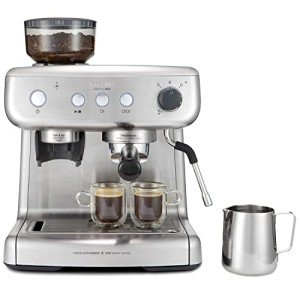What Is Stainless Steel Espresso Machines? History Of Stainless Steel Espresso Machines
The Art of Italian Espresso Machines: A Brewed Tradition
Italian espresso machines are not just home appliances; they are an important part of Italy's rich coffee culture, representing a mix of artistry, engineering, and style. Coffee enthusiasts around the globe acknowledge the importance of high-quality espresso, a staple of Italian life and food. This short article checks out the history, mechanics, types, and aspects to think about when buying an Italian espresso machine, reflecting the depth of this beloved drink and its developing techniques.
History of Espresso Machines
The espresso machine's development go back to the early 20th century in Italy, where coffee was not merely a beverage but an important social ritual. The preliminary efforts to brew espresso started with basic, stove-top designs, slowly evolving into complex machines that could replicate the best brew.
- 1901— The First Espresso Machine: The first steam-powered espresso machine, called the “Ideale,” was established by Luigi Bezzera. This equipment marked a turning point in espresso developing.
- 1938— The Lever Machine: The introduction of the lever machine made it much easier to control the pressure used in espresso extraction, boosting taste consistency.
- 1947— The Automatic Machine: Reaching more customers, Gaggia introduced the first automatic espresso machine, further promoting espresso bars.
- 2007— The Digital Age: Technological developments caused the birth of completely programmable machines, allowing users to customize their brewing settings to achieve a tailored coffee experience.
Key Features of Italian Espresso Machines
Italian espresso machines embody accuracy, craftsmanship, and development. Here are some key parts that highlight their significance:
Feature
Description
Boiler Type
Figures out how heat is generated and kept. Typical types include single boiler, dual boiler, and heat exchanger.
Group Heads
Where the coffee is brewed; commercial machines often have multiple group heads for effectiveness.
Pressure Control
Vital for attaining the perfect espresso; most machines run at 9 bars of pressure.
Frothing Capabilities
The steam wand enables for milk frothing, necessary for drinks like cappuccino and latte.
Construct Quality
The products utilized (stainless-steel, brass, and so on) impact sturdiness and heat retention.
Types of Italian Espresso Machines
Selecting the ideal machine hinges on user preferences, budget, and planned use. Below are the primary kinds of Italian espresso machines:
Manual Espresso Machines
- Pros: Offer complete control over the brewing procedure, permitting for a tailored touch.
- Cons: Require skill and practice, can be labor-intensive.
Semi-Automatic Machines
- Pros: Provide a balance between automated and manual procedures; users manage water flow.
- Cons: Can have a steeper knowing curve than fully automatic machines.
Fully Automatic Machines
- Pros: Simplify the developing process with push-button operations; ideal for novices.
- Cons: May sacrifice a few of the subtleties of manual developing.
Super-Automatic Machines
- Pros: Grind, tamp, brew, and froth automatically; convenient for hectic way of lives.
- Cons: Less control over the developing variables, potential for a less genuine espresso experience.
Purchasing Guide: Factors to Consider
Choosing the ideal Italian espresso machine can be overwhelming, but thinking about the following factors can streamline the decision-making procedure:
- Budget: Italian espresso machines range from affordable to high-end designs, so set a budget upfront.
- Usage Frequency: Evaluate how typically you will use the machine; day-to-day users might desire a more long lasting alternative.
- Area: Measure your kitchen or counter area; some machines can be large and require sufficient clearance.
- Upkeep: Consider ease of cleaning; machines with removable parts or integrated cleaning functions might minimize upkeep.
- User Skill Level: Beginners may prefer totally or semi-automatic machines, while knowledgeable baristas can manage manual machines.
- Brand Reputation: Research brand names known for quality, such as Breville, Gaggia, and La Marzocco.
Popular Italian Espresso Machine Brands
Italian craftsmanship is renowned for producing a few of the very best espresso machines worldwide. Here are top brands worth considering:
- Gaggia: Known for its home espresso machines and price.
- La Marzocco: A superior brand name understood for its commercial-grade machines and ingenious technology.
- Rancilio: Renowned for its resilient construct and professional-quality machines ideal for home and commercial use.
- Sage/Breville: Offers advanced functions and user-friendly designs, ideal for both novices and lovers.
Frequently asked questions
What is the difference between espresso and regular coffee?
Espresso is a focused coffee brewed by requiring hot water through finely-ground coffee under pressure. It has a thicker consistency, richer taste, and greater caffeine concentration than routine coffee.
Can I make milk-based drinks with an espresso machine?
Yes, many Italian espresso machines feature a steam wand to froth milk for drinks like cappuccinos, lattes, and macchiatos.
How frequently should I clean my espresso machine?
Routine maintenance is essential. Typically, a thorough cleaning is recommended every couple of weeks, while descaling needs to be done every 1 to 3 months, depending upon water solidity.
What is the ideal pressure for developing espresso?
The ideal pressure for developing espresso is around 9 bars. This pressure ensures the optimal extraction of tastes from the coffee premises.
Are more costly machines worth the investment?
Higher-end machines often use better products and innovation, providing improved toughness and more consistent outcomes. For major coffee enthusiasts, investing in a good machine can raise the espresso experience significantly.
Italian espresso machines are much more than simple brewing gadgets; they are an event of a cultural tradition that has actually influenced coffee intake worldwide. With different designs offered to fit any user's needs— varying from beginners to seasoned baristas— there is an Italian espresso machine perfectly suited for everybody. As Buy Coffee Maker start your espresso journey, comprehending the history, mechanics, and options will enhance your experience and appreciation for this time-honored drink. Whether you seek to recreate a café atmosphere in the house or improve your developing strategy, these machines are capable of providing unforgettable cups of espresso embellished with the abundant history of Italian coffee culture.
